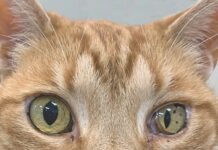You may be hard-pressed to find scientific studies on this, but anecdotal evidence abounds at veterinary clinics: When owners learn their cat needs a “dental cleaning,” a lay term for periodontal treatment, most of them are alarmed — specifically about the risks of anesthesia. Some even delay treatment because of their concern.
The reality today is that improvements in pain management, a wider variety of anesthetics and sophisticated monitoring have resulted in greater safety than ever. Most of the studies on feline mortality related to anesthesia indicate the risk is less than 1 percent.
“When administered by trained personnel, modern-day general anesthesia is very safe in dogs and cats — much safer than many owners think,” says Santiago Peralta, DVM, AVDC, Section Chief of Dental and Oral Surgery at Cornell University College of Veterinary Medicine.
Rare Complications.
Furthermore, age is not usually considered a significant risk factor in healthy cats, Dr. Peralta says. “Systemically sick animals of any age are always at higher anesthetic risk compared to healthy individuals. Some diseases represent a higher risk than others — for example, cardiac disease. In order to minimize or be able to anticipate and be better prepared for anesthetic complications, a complete physical examination and diagnostic tests as determined by the individual’s medical history, physical examination findings and clinician’s discretion are performed prior to anesthesia. The result is that serious anesthetic complications rarely occur.”
General anesthesia using inhaled anesthetic agents has become the veterinary standard for dental procedures. The American Animal Hospital Association recommended it three years ago for cats and dogs. In addition, Dr. Peralta points out that general anesthesia is vital to dental procedures because it provides these benefits:
1. Protection of the airway with an endotracheal tube reducing the risk of inhaling heavily contaminated solid and aerosolized particles produced during periodontal treatment.
2. Use of instruments to probe and remove deposits under the gum line, which is essential in most dental procedures. “It is precisely under the gum line where periodontal, or gum, disease occurs,” Dr. Peralta says.
3. Ability to perform surgical interventions as indicated by probing and X-ray findings, such as extractions, biopsies and root canal treatments.
Regional blocks, which numb only areas that need surgery, continue to be a mainstay in dentistry. The procedure, in which the veterinarian injects a local anesthetic near a cluster of nerves, allows the patient to recover from general anesthesia much more comfortably, while additional pain medications are administered as needed.
Regional blocks also allow much lower doses of general anesthetics to be used, thus reducing the risk of side effects, Dr. Peralta says. “The most common complication when administering regional blocks consists of bruising at the injection site. This complication is minor and usually resolves spontaneously after a few hours or days.”
More serious complications are very rare when a block is administered by properly trained personnel, he says. These include accidental needle penetration of the eye while administering the block and injury to the cat’s tongue during recovery if it has been accidentally desensitized.
“The cost of administering regional blocks when indicated is minimal and is oftentimes included in the charges for the procedure performed,” Dr. Peralta says. “On the other hand, the cost of general anesthesia usually represents a significant portion — about 30 to 40 percent — of the bill.”
In order to minimize the risk of periodontal disease, experts recommend daily toothbrushing, regular oral examinations and periodontal treatment when considered necessary by the attending veterinarian. Periodontal treatment begins with an assessment to determine a cat’s general health and is often followed by other diagnostic tests that may include blood and urine tests, chest X-rays and electrocardiography.
First, a Sedative.
Before your cat undergoes anesthesia for dental care, ask the veterinarian about the type that will be used, how your cat will be monitored and who will administer it. When it’s time for surgery, the cat will usually first be given a pre-anesthetic sedative and an injection for pain relief. The advantages of preemptive treatment include lowered stress on the patient, ease of handling and reduction of anesthetic dose.
After the sedative takes effect, the veterinarian or anesthetist will place an intravenous catheter into a vein in a front or hind limb, or occasionally in the neck. The catheter provides access to the patient’s blood stream to administer fluids and drugs during surgery. Fluids help to combat dehydration and a possible anesthesia-induced drop in blood pressure.
The veterinarian often begins general anesthesia by administering an injectable short-acting anesthetic agent. When the cat loses consciousness, a soft plastic endotracheal tube is inserted into the windpipe and connected to an anesthesia machine. The machine delivers an inhaled anesthetic mixed with oxygen. Continuous or intermittent doses of injectable agents, or a combination of injectable and inhaled drugs can be used, depending on a patient’s health and needs.
Anesthetic monitoring devices attached to the cat help ensure his safety. “Monitoring typically includes continued measurement of body temperature, oxygen saturation, carbon dioxide concentration, electrocardiogram and blood pressure,” Dr. Peralta says. After the procedure, the cat slowly regains consciousness and is moved to a post-surgical area and monitored during recovery from the anesthesia. Cats receiving routine periodontal treatment can usually be discharged the same day.
The veterinarian will provide pain relief for cats who have had tooth extractions or other invasive procedures. Options may include oral or injectable medications, or transdermal patches. Others might be sent home with an oral pain medication and, in some cases, antibiotics to prevent or treat ongoing infection. Cats may be a little groggy but far healthier after receiving comprehensive dental care.



